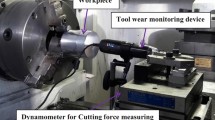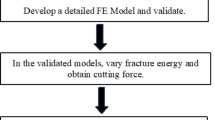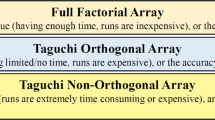Abstract
The paper presents a finite element based methodology by converting full scale turning operation to a two-dimensional plain strain machining model. The method is used for predicting the output cutting parameters by using the Johnson cook elastic and fracture model to improve the prediction capabilities for industrial applications. For material modeling purposes, ABAQUS Explicit module is used by taking coupled temperature displacement elements. Different input cutting regimes, i.e., feed rate, depth of cut, and cutting speed, have been varied to evaluate the values of cutting force, cutting temperature and also the effect of tool particle interaction for the turning of SiC (100 μm, 10% wt.) reinforced Al7075 composite. Moreover, to view the effect of variation of material and dimensional property fracture energy has been varied. Further, the response surface model is developed by using full factorial design to generate the regression equations for the estimation of output variables within the selected input variables range. A number of 256 different simulations were executed, out of which 230 were used for the training purpose, and 26 for validation purposes. Results depict the prediction error of the regression model for validatory runs, which varies from 0.21 to 17.13% for Fc, Ft, and Tt, respectively. The finite element model is validated with experimental analysis by examining a set of 8 random runs. Prediction accuracy based on the above comparison varies from 83.33 to 93.68% for cutting force components and cutting temperature. It is also observed that the finite element model and the response surface model are having a good agreement with experimental results.
Similar content being viewed by others
References
Chawla N, Chawla KK (2013) Metal Matrix Composites. Second, Springer-Verlag New York
Dandekar CR, Shin YC (2012) Modeling of machining of composite materials: a review. Int J Mach Tools Manuf 57:102–121
Ghandehariun A, Nazzal M, Kishawy HA, Umer U (2017) On modeling the deformations and tool-workpiece interactions during machining metal matrix composites. Int J Adv Manuf Technol 91:1507–1516
Ding X, Liew WYH, Liu XD (2005) Evaluation of machining performance of MMC with PCBN and PCD tools. Wear 259:1225–1234
Muthukrishnan N, Murugan M, Rao KP (2008) An investigation on the machinability of Al-SiC metal matrix composites using pcd inserts. Int J Adv Manuf Technol 38:447–454
Manna A, Bhattacharayya B (2003) A study on machinability of Al/SiC-MMC. J Mater Process Technol 140:711–716
Setia S, Chauhan SR (2020) An improved artificial neural metworking architechture approach for prediction of cutting parameters in turning of EN31 steel. Optimization methods in engineering select procedding of CPIE 2019. Springer, First, pp 377–398
Saini A, Dhiman S, Sharma R, Setia S (2014) Experimental estimation and optimization of process parameters under minimum quantity lubrication and dry turning of AISI-4340 with different carbide inserts. J Mech Sci Technol 28:2307–2318
Kishawy HA, Kannan S, Balazinski M (2004) An energy based analytical force model for orthogonal cutting of metal matrix composites. CIRP Ann - Manuf Technol 53:91–94
Ghandehariun A, Kishawy H, Balazinski M (2016) On machining modeling of metal matrix composites: a novel comprehensive constitutive equation. Int J Mech Sci 107:235–241
Zhu Y, Kishawy HA (2005) Influence of alumina particles on the mechanics of machining metal matrix composites. Int J Mach Tools Manuf 45:389–398
Zhou L, Huang ST, Wang D, Yu XL (2011) Finite element and experimental studies of the cutting process of SiCp/Al composites with PCD tools. Int J Adv Manuf Technol 52:619–626
Teng X, Huo D, Chen W, Wong E, Zheng L, Shyha I (2018) Finite element modelling on cutting mechanism of nano mg/SiC metal matrix composites considering cutting edge radius. J Manuf Process 32:116–126
Pramanik A, Zhang LC, Arsecularatne JA (2007) An FEM investigation into the behavior of metal matrix composites: tool-particle interaction during orthogonal cutting. Int J Mach Tools Manuf 47:1497–1506
Zhou L, Wang Y, Ma ZY, Yu XL (2014) Finite element and experimental studies of the formation mechanism of edge defects during machining of SiCp/Al composites. Int J Mach Tools Manuf 84:9–16
Zhang PF, Zhou L, Ran YC (2020) Finite element analysis and comparison of the machinability of SiCp/Al composite and CNT/Al composite. J Inst Eng Ser C 101:323–329
Ghandehariun A, Kishawy HA, Umer U, Hussein HM (2016) On tool–workpiece interactions during machining metal matrix composites: investigation of the effect of cutting speed. Int J Adv Manuf Technol 84:2423–2435
Ghandehariun A, Kishawy HA, Umer U, Hussein HM (2016) Analysis of tool-particle interactions during cutting process of metal matrix composites. Int J Adv Manuf Technol 82:143–152
Sisto TS De, Carl FL, Larson FR (1964) The influence of section size on the mechanical properties and fracture toughness of 7075-T6 Aluminum, 6Al-6V-2Sn Titanium, And AISI 4340 Steel
Mabrouki T, Girardin F, Asad M, Rigal JF (2008) Numerical and experimental study of dry cutting for an aeronautic aluminium alloy (A2024-T351). Int J Mach Tools Manuf 48:1187–1197
Bayraktar Ş, Afyon F (2020) Machinability properties of Al–7Si, Al–7Si–4Zn and Al–7Si–4Zn–3Cu alloys. J Brazilian Soc Mech Sci Eng 42:1–12
Bayraktar Ş, Demir O (2020) Processing of T6 heat-treated Al-12Si-0.6Mg alloy. Mater Manuf Process 35:354–362
Bayraktar Ş, Hekimoğlu AP (2020) Effect of zinc content and cutting tool coating on the machinability of the Al-(5–35) Zn alloys. Met Mater Int 26:477–490
El-Gallab M, Sklad M (1998) Machining of Al/SiC particulate metal-matrix composites: part I: tool performance. J Mater Process Technol 83:151–158
El-Gallab M, Sklad M (1998) Machining of Al/SiC particulate metal matrix composites part II: Workpiece surface integrity. J Mater Process Technol 83:277–285
El-Gallab M, Sklad M (2000) Machining of Al/SiC particulate metal matrix composites. Part III: Comprehensive tool wear models J Mater Process Technol 101:10–20
Tomac N, Tonnessen K, Rasch FO (1992) Machinability of particulate Aluminium matrix composites. CIRP Ann - Manuf Technol 41:55–58
Andrewes CJE, Feng HY, Lau WM (2000) Machining of an aluminum/SiC composite using diamond inserts. J Mater Process Technol 102:25–29
Kumar R, Chauhan S (2015) Study on surface roughness measurement for turning of Al 7075/10/SiCp and Al 7075 hybrid composites by using response surface methodology (RSM) and artificial neural networking (ANN). Measurement 65:166–180
Bhushan RK, Kumar S, Das S (2010) Effect of machining parameters on surface roughness and tool wear for 7075 Al alloy SiC composite. Int J Adv Manuf Technol 50:459–469
Das D, Pradhan SK, Sahoo AK et al (2019) Tool wear and cutting force investigations during turning 15 wt% SiCp-Al 7075 metal matrix composite. Mater Today Proc 26:854–859
Bayraktar Ş, Turgut Y (2020) Determination of delamination in drilling of carbon fiber reinforced carbon matrix composites/Al 6013-T651 stacks. Measurement 154:1–11
Dey A, Debnath S, Pandey KM (2017) Optimization of electrical discharge machining process parameters for Al6061/cenosphere composite using grey-based hybrid approach. Trans Nonferrous Met Soc China 27:998–1010
Muthusamy Subramanian AV, Nachimuthu MDG, Cinnasamy V (2017) Assessment of cutting force and surface roughness in LM6/SiCp using response surface methodology. J Appl Res Technol 15:283–296
Thakre AA, Soni S (2016) Modeling of burr size in drilling of aluminum silicon carbide composites using response surface methodology. Eng Sci Technol an Int J 19:1199–1205
Das B, Roy S, Rai RN, Saha SC (2016) Study on machinability of in situ Al–4.5%cu–TiC metal matrix composite-surface finish, cutting force prediction using ANN. CIRP J Manuf Sci Technol 12:67–78
Rajeswari B, Amirthagadeswaran KS (2017) Experimental investigation of machinability characteristics and multi-response optimization of end milling in aluminium composites using RSM based grey relational analysis. Meas J Int Meas Confed 105:78–86
Jagota V, Sharma RK (2018) Interpreting H13 steel wear behavior for austenitizing temperature, tempering time and temperature. J Brazilian Soc Mech Sci Eng 40:1–12
Balasubramanian K, Nataraj M, Duraisamy P (2019) Machinability analysis and application of response surface approach on CNC turning of LM6/SiCp composites. Mater Manuf Process 34:1389–1400
Joardar H, Das NS, Sutradhar G, Singh S (2014) Application of response surface methodology for determining cutting force model in turning of LM6/SiCP metal matrix composite. Meas J Int Meas Confed 47:452–464
Brar NS, Joshi VS, Harris BW (2009) Constitutive model constants for Al7075-T651 and Al7075-T6. AIP Conf Proc 1195:945–948
Bolar G, Joshi SN (2014) 3D finite element modeling of thin-wall machining of aluminum 7075-T6 alloy department of. In: 5th international & 26th all India manufacturing technology, design and research conference (AIMTDR 2014). Pp 1–6
Chauhan S, Krishna UG, Setia S (2020) Finite element based simulation model for micro turning of nanoparticle-reinforced aluminum alloy 7075-T6 composite. Manufacturing engineering select Proceddings of CPIE 2019. Springer, First, pp 561–574
Montgomery D (2001) Design and analysis of experiments. Fifth, John Wiley and Sons INC
Acknowledgments
The present work was performed in the state of the art facility of M.E. Workshop, NIT Hamirpur. The work was funded by the ME Department, NIT Hamirpur, 177005, India.
Author information
Authors and Affiliations
Corresponding author
Additional information
Publisher’s Note
Springer Nature remains neutral with regard to jurisdictional claims in published maps and institutional affiliations.
Rights and permissions
About this article
Cite this article
Setia, S., Chauhan, S.R. Comparative Analysis and Optimization of FEM and RSM Based Regression Model with Experimental Results for the Dry Turning of SiCp- Al7075 Composite. Silicon 13, 4681–4701 (2021). https://doi.org/10.1007/s12633-020-00711-y
Received:
Accepted:
Published:
Issue Date:
DOI: https://doi.org/10.1007/s12633-020-00711-y




